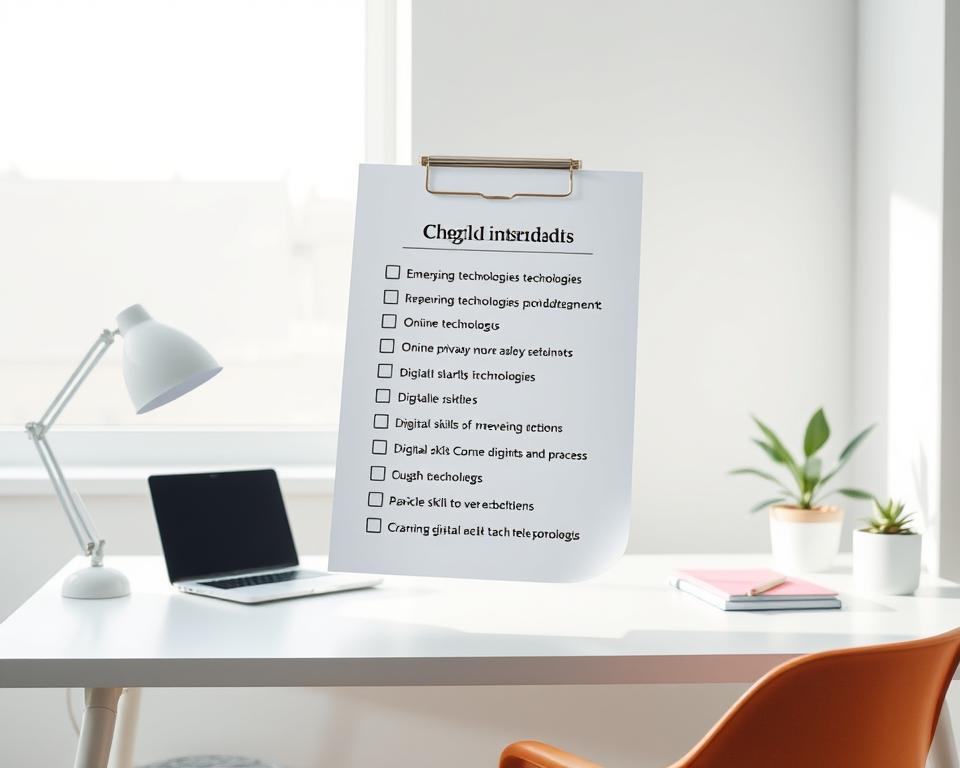Anúncios
Digital Trends trends 2025 began with clear numbers: 5.56 billion internet users, 5.78 billion mobile accounts, and 5.24 billion social identities.
Have you wondered why this year feels different for your audience and ad spend?
The average adult now spends about 6 hours 38 minutes online. Entertainment time sits near six hours daily. That shift means your wins come from smarter minute allocation, not chasing more hours.
AI is no longer experimental. Tools like ChatGPT, Gemini, Copilot, and Meta AI are shaping creation, recommendations, and media planning. Social platforms are the gravity well for attention and ad dollars.
What you can do right now is practical: use first-party data, test creative weekly with AI-assisted tools, and balance SVOD, social discovery, and creator partnerships to avoid overexposure.
Principais conclusões
- People spend roughly six hours a day on entertainment and 6:38 online—allocate minutes wisely.
- Social platforms capture attention and ad dollars; optimize for discovery, not just placement.
- AI tools speed testing and creative iteration—use them to refine your media mix.
- Mobile leads access, but living room screens matter for premium events and video.
- Rely on first-party signals and weekly tests to reduce churn and increase relevance.
Introduction: Digital Trends trends 2025 at a glance
Data show adults now spend about 6 hours and 38 minutes online each day, and that changes how you compete for attention.
At a high level, this year feels different because social platforms, creators, and AI-enhanced ad tech compress attention and budgets into a tighter window.
Why this year feels different for media, apps, and devices
You’re competing inside a roughly six-hour entertainment window. Small wins in discovery, relevance, and retention beat one-off big bets.
How your time, money, and attention are shifting
Streaming households now average four paid SVOD services at about $69/month, while pay TV subs fell from 63% to 49% in three years.
The median U.S. household feels price pressure, so subscription growth is capped and switching behavior rises.
What our sources reveal about users, platforms, and growth
Our analysis combines Deloitte consumer surveys and We Are Social/Meltwater global data. These sources show how users split time across mobile, living-room video, UGC, and audio.
Use this report as a practical guide and validate specifics with official platform reports, regulators, and primary research when you plan campaigns.
- Quick moves: faster onboarding, smarter bundles, creator-led launches.
- Focus: lighter, more relevant ad loads to protect retention.
- Watch: mobile video gains and living-room migration for premium moments.
The state of digital in the United States and beyond
With billions online, your campaigns must work across screens and habits. The numbers show scale: 5.56 billion internet users and 5.78 billion mobile accounts. That reach shifts how you plan media and measure impact.
Users, devices, and time online: scale and momentum
Smartphones are about 87% of handsets, so assume mobile-first creative, checkout, and vertical video by default.
Your market now includes 5.24 billion social identities; platforms fragment attention but also give precise entry points for targeting.
- Audience: 5.56B users—accessible but split by platform and device.
- Devices: prioritize fast load times, captions, and vertical framing for phones.
- Time: adults average 6h38m/day online; younger cohorts spend more.
What six-and-a-half hours online a day means for content
Internet reach exceeds linear TV globally, so discovery paths and media baselines have changed. You must trade share within a capped daily window, not chase infinite growth.
Use device-specific hooks: quick value on mobile and higher bitrate, immersive audio for living-room viewing. Small optimizations in sign-in, recommendations, and load speed cut drop-offs and lift session depth.
Attention is capped: the six-hour entertainment window
You only have a few meaningful minutes each day to win attention—so design for them. Adults split roughly six hours of entertainment across apps, services, and screens. That means every interaction must earn time fast.
Fragmentation across SVOD, social, gaming, and audio
Where users spend time
People divide sessions between SVOD, social video, games, podcasts, and music. Use cross-promotion and short playlists to guide viewers from a clip to a longer session.
Practical ways you can compete for minutes, not days
Simple tactics that work
- Build for minutes: shave friction from sign-in and playback to capture the first 60–120 seconds, then the next 5–10 minutes.
- Smarter discovery: surface watch lists, social proof, and creator picks so users pick faster.
- Lighter onboarding: defer payment, auto-download a starter asset, and personalize with one tap.
- Measure minutes: A/B test thumbnails and openers and track incremental minutes gained.
- Respect time: clear ad clocks and fewer repeats keep session length healthy.
Track data weekly. If minutes per session fall, simplify the next action and surface fewer, better choices.
Pay TV keeps revenue, loses users: what that means for 2025
Pay TV still earns clear revenue, even as subscriber counts shrink across the U.S. market. About 49% of consumers now have cable or satellite, down from 63% three years ago. Households pay roughly $125/month, which explains why younger users look for cheaper options.
Who stays for live news and sports—and who’s leaving
Live events keep people attached. Data show 43% cite live news and 41% cite sports as the main reasons to keep service. That gives you clear levers for cross-promotion and upsells tied to marquee moments.
Virtual MVPDs sit near 40% of households and growth has stalled. Pricing still skews to legacy buyers, so value-seeking streamers often avoid these platforms.
- Plan for erosion: expect steady subscriber declines even as ad and carriage revenues hold.
- Target offers: bundle live sports with on-demand libraries to retain Gen Z and Millennials.
- Creative strategy: reduce ad repetition, manage frequency caps across platforms, and push live social extensions to capture second-screen attention.
Watch near-term cancellation rates. If they tick up, trigger save offers tied to the next big live event rather than broad discounts. This keeps churn lower and preserves revenue per user.
SVOD economics: value, price sensitivity, and churn
Subscription wallets are tight—so you must prove the value of each service within weeks, not months. Households now average four paid services and spend about $69/mês. That number shapes how you price, program, and promote.
From four services to higher bills: the $69/month reality
Plan around a $69 monthly household spend. Adding a fifth service requires a clear, unique hook—exclusive franchises, live sports, or bundled broadband.
Price sensitivity is sharp: $14 feels “just right” for ad-free. $25 drives many away. A $5 hike makes ~60% likely to cancel their favorite service.
Churn and return patterns among Gen Z and millennials
Churn runs near 39% in six months and tops 50% for Gen Z and Millennials. Protect retention with seasonal calendars, annual plans, and pause options.
Keep profiles and watchlists so returning users re-engage fast; re-acquisition costs rise quickly if you lose session history.
Ad tiers vs. premium: how you calibrate perceived value
Ad-supported tiers average about $9 and work when ad loads are light. Target roughly eight minutes of ads per hour, vary creatives, and cut repetition.
- Price moves: stagger increases and attach visible new value.
- Onboarding: use intro-month pricing, one-click profiles, and pre-filled watchlists.
- Content cadence: cluster tentpoles and fill gaps with shorts and specials.
- Medir: track month 2 and month 3 retention by cohort; test ad load cuts before changing price.
Ads follow engagement: social platforms capture spend
Ads flow where attention lives, and right now attention clusters in social feeds and short-form video. That shift affects how you plan buys, craft creative, and measure impact.
Use ad tech and AI to make smarter moves. Platforms offer tools for audience expansion, dynamic creative, and adaptive sequencing. These let you reach users with relevant spots and reduce fatigue.
But repetition on streaming and cable is a real problem. Viewers report that repeat ads shorten sessions and push up churn. Your creative cadence matters as much as placement.
Ad tech advantage, AI targeting, and creative iteration
- Shift budgets toward platforms where users engage most often and signal purchase intent.
- Leverage platform tools for creative testing and audience expansion; let AI suggest variants but always review for brand fit.
- Start social for discovery, then retarget on CTV with mid-funnel storytelling and clear watch-next paths.
Why ad repetition hurts streaming engagement
- Rotate creatives aggressively on streaming; repetition is a top complaint that shortens sessions.
- Align frequency caps across publishers to avoid back-to-back duplicate spots across platforms.
- Test 6s and 15s in pods; save 30s+ for flagship moments and live tentpoles.
- Use attention metrics (hover, plays, scroll stops) not impressions alone to optimize spend.
Faça isto: coordinate your buys, measure incremental lift by platform, and pull budget where frequency yields no extra engagement.
Creators redefine video: the UGC and parasocial advantage
Your audience often trusts creators more than networks, and that changes how media performs.
Creators win on relevance. About 56% of Gen Z and 43% of Millennials say social content feels more relevant than TV or movies. Those creators build communities that act like a built-in focus group and distribution channel.
Work with creators early to co-create concepts and ad integrations that feel native and honest. Give them data on watch-time drops and audience interests so they can refine arcs instead of guessing.
Use platform-native tools to accelerate discovery and cross-pollinate audiences. Diversify cuts for TikTok, Reels, Shorts, and Snap so IP stays modular when algorithms shift.
- Measure beyond views: track saves, shares, and click-throughs to long-form or product pages.
- Plan serial formats: recurring hooks turn parasocial bonds into sustained engagement.
- Respect autonomy: over-scripting reduces authenticity and hurts performance.
Digital Trends trends 2025 in discovery and shopping
Social discovery now shapes purchase intent like price and reviews once did, so your funnel must mirror browsing behavior. Start with where users spend time: short videos, creator reviews, and social search. Those touchpoints form first impressions that lead to faster decisions.
Social product discovery and influencer impact
Use influencers to build trust at the top of the funnel. Let creators demo products and answer common questions in the native tone of their audience.
Benchmark by engagement, not just quick sales: saves, shares, and comments often predict later purchases. Map campaigns by cohort—Gen Z favors social proof and voice, older users want specs and guarantees.
From awareness to conversion: simplifying your path
Keep the path short. Deep-link from a short clip to a single product page or a pre-filled cart for one-tap checkout. Add clear social proof above the fold: UGC, ratings, and returns policy.
- Retarget viewers with shoppable creatives that match the original content tone.
- Use catalog feeds and product tags to surface variants without extra taps.
- Test live shopping only if your audience already engages with streams.
- Blend platform data with server-side tagging to avoid over-crediting last click.
Practical funnel steps: attract with short-form content, build trust with creators, shorten the checkout path, and support buyers with post-purchase how-tos to lower returns. Those moves turn discovery into repeatable shopping outcomes.
Mobile video at staggering scale
As phones lead access, your media must flex between rapid bites on handhelds and richer cuts on the big screen.
The numbers matter: there are roughly 5.78 billion mobile users, and smartphones make up about 87% of handsets. That data explains why you design for vertical first, then adapt for living rooms.
Short-form dominance and living room migration
Short-form video wins discovery on feeds, but major platforms now push apps into TV ecosystems. That shift means your creative should seed interest on phones and reward full attention on TV.
- Design mobile-first: vertical framing, fast openers, on-screen text, and clear CTAs for silent autoplay.
- Sequence across screens: teaser on mobile, mid-form explainer on desktop, premium cut on TV—track minutes and watch-time by device.
- Prepare TV edits: horizontal cuts, higher bitrates, and cleaner audio to meet living-room expectations.
- Measure and prune: use completion data and quick analysis to remove weak intros and rotate fresh creative.
In practice, use the first three seconds to show payoff, test upload specs to avoid artifacts, and balance frequency on CTV to protect session time. Do this and you’ll capture minutes across devices and platforms.
Audio’s steady rise: music and podcasts in your mix
Audio now fills the spaces where screens can’t—commutes, chores, and workouts—so plan for it. Deloitte data show music and podcasts make up an increasing share of the six-hour entertainment mix. That means you can reach users when they aren’t looking at a screen.
Keep it simple and practical: add short audio ads with clear value propositions and test host-read spots for higher trust and recall. Podcasts build deeper relationships; serialized formats bring listeners back weekly.
- Reach users off-screen: target commutes, workouts, and chores to grab repeated daily attention.
- Cross-promote: clip podcast highlights into Shorts and Reels to feed discovery loops and drive listeners to long-form content.
- Measure for the long run: use promo codes, vanity URLs, and transcripts to track lift and improve SEO from episode text.
- Schedule smart: track time-of-day listening to drop episodes and ads when attention peaks.
Bundle audio with video memberships to raise perceived value without a big cost. Keep episodes tight by using chapters and timestamps so users find value fast.
Gaming and live sports: the engagement flywheel
Clips and live moments form an engagement flywheel that seeds interest, drives replays, and prompts users to return for full events. Use short pieces to attract attention, then guide viewers toward longer watch paths.
Clips, highlights, and watch-time tradeoffs
Be clear about goals: tease, don’t replace. Younger users often consume play-by-play clips on social, which can reduce full-match viewing if clips are too long or abundant.
- Seed interest: use short highlight clips before live starts; cap length so you spark curiosity without giving the whole payoff.
- Creator-led hooks: gaming thrives on personalities—post recaps, loadouts, and tips to keep users returning between streams.
- Measure clip-to-stream conversion: track data on who converts to full replays; if conversion drops, cut volume and raise exclusivity.
- Rights and platforms: confirm geo-rights and cross-post rules so users don’t hit dead links or confusion.
- Balance minutes: schedule clips in quiet windows and build chaptered VOD for rewatchers to protect full-event minutes.
Faça isto: align creative, schedule, and measurement so clips grow engagement without cannibalizing long-form media.
AI gains you can’t ignore: apps, assistants, and integration
You don’t need a full overhaul to benefit from AI — start with one tool that shortens a key task. Assistants now live inside apps and services you already use. That makes testing low-risk and fast.

ChatGPT, DeepSeek, Gemini, and Copilot in daily use
ChatGPT reaches hundreds of millions of users and drives billions of visits monthly. Gemini, Copilot, DeepSeek, and Meta AI also show rapid adoption.
Use these tools for drafts, outlines, and quick analysis. Always add human review for brand tone and legal checks.
Integrated AI in search, productivity, and creation
Embed AI in search workflows for query expansion and entity mapping. In productivity suites, use built-in copilots for notes, slides, and action items.
Synthetic media, recommendations, and content workflows
Synthetic media speeds production, but label it and follow disclosure rules. Train recommendation systems with clean metadata and audience signals.
- Pilot small: run one channel test and compare to human-only baselines.
- Build guardrails: prompts, style guides, and approval flows keep outputs on-brand.
- Measure by cycle time saved and test velocity, not just volume.
Devices and demographics: how age shifts behavior
Age shapes where you spend attention and which devices carry it. Younger users favor mobile-first moments and short social clips. Older viewers lean on TV, tablets, and news for longer sessions.
Gen Z vs. Boomers: time, platforms, and content types
Keep segmentation simple. Gen Z spends more minutes on social video, UGC, and gaming. Prioritize short-form, interactivity, and creator ties for that group.
Boomers prefer long-form TV and news. Use clear navigation, larger fonts, and higher contrast to improve completion and accessibility.
- Agendar posts around school and work rhythms for younger users; aim daytime news and evening long-form for older audiences.
- Devices: mobile dominates for Gen Z; older users split time between TV and tablets. Design cuts and CTAs per screen.
- Subscriptions: younger cohorts churn faster; older users respond to annual plans and live-news bundles.
- Testing: vary caption density and pace by cohort to reduce drop-offs and lift engagement.
- Reporting: separate cohorts in your analysis so averages don’t hide wins or losses.
Segment emails and push notifications by age and device preference to lift response rates. For practical guidance and deeper consumer data, see this research summary.
Marketer playbook: measurement, mixes, and outcomes
Start with a clean measurement spine. Stand up server-side tagging, consented first-party data, and calibrated pixels so your analysis rests on accurate signals.
Map journeys clearly. Track social discovery → product page → CTV retarget → email/cart and measure lift at each step. Use holdouts and geo tests to validate platform-reported results and avoid double counting.
Attribute across channels with two lenses: MMM for long-term shifts and MTA for short-term actions. Align on one source of truth for revenue so companies report consistent cohort value.
Creative testing at speed with AI-enhanced tools
Use AI tools to iterate hooks, titles, thumbnails, and lengths weekly. Run small A/Bs and measure assisted conversions, cost per retained subscriber, and minutes gained per ad exposure.
- Measure rates that matter: assisted conversions, retention, and minutes per exposure.
- Build media mixes by context: mobile short-form for awareness, CTV for storytelling, search for harvest.
- Share findings across product, UX, and marketing so insights improve onboarding and services.
Trust, safety, and governance in a synthetic era
You need clear rules for privacy, brand safety, and AI risk management when synthetic media and recommendation engines shape more of your feeds. Users expect transparency about how their data and profiles are used, and you should meet that expectation plainly.
Privacy expectations, brand safety, and AI TRiSM basics
Start with consent and clarity. Tell users what data you collect and why, and provide simple controls to opt out or adjust personalization.
- Build AI TRiSM guardrails: bias checks, explainability notes, and audit logs for key workflows.
- Pre-screen creators and placements to avoid adjacency issues; keep updated blocklists and allowlists.
- Label synthetic media clearly and follow platform policies to preserve awareness and reduce confusion.
- Answer hard questions first: where did training data come from; who signs off on outputs; how will errors be handled?
- Use brand suitability tools and contextual targeting to improve safety without overblocking.
Track impact and compliance: measure brand lift and complaint trends, train teams on impersonation risks, and run quarterly reviews of platform and regulatory changes.
Where companies and creators find advantage in 2025
Companies that combine smart bundles with creator partnerships gain measurable advantage fast. Keep moves simple and testable so you see what works for users and the market.
Bundles, partnerships, and smarter pricing
Bundle to lower perceived cost: pair your services with music, cloud storage, or loyalty perks to make monthly bills feel smaller.
Offer targeted pricing: student, family, and off-peak plans reduce churn without broad discounts. Pilot one market, measure retention and ARPU, then scale.
Building durable engagement beyond algorithms
Work with creators for co-branded launches. Tie their efforts to clear KPIs—sign-ups, watch minutes, or trials—so you track real success.
- Share select data with partners to improve personalization while protecting privacy.
- Use email, SMS, and community spaces to hold attention between drops.
- Refresh onboarding quarterly using the top three friction fixes from user feedback.
For steady growth: align content calendars to sports and holiday peaks, celebrate user milestones, and run small pilots before wider rollouts.
Methodology notes and source context
Numbers shift when population baselines change, so percentages can move even if the raw user counts hold steady. You should treat headline figures as starting points for planning, not final answers.
Why population baselines and platform reporting matter
Be clear about sources. We rely on UN World Population Prospects 2024 for population denominators, DataReportal/We Are Social/Meltwater (Feb 2025) for internet, mobile, and social snapshots, and Deloitte’s 2025 consumer survey for U.S. media behavior.
- Population baselines: revisions in 2024 can change percent-based metrics even if the raw number of users stays flat.
- Counting differences: “user identities,” logged accounts, and unique visitors are not the same—check definitions before you compare platforms.
- Timing and lags: some datasets update monthly; others lag by months or years—cross-check latest month reports when a number looks off.
- Segment for accuracy: inclusion of 65+ in panels since 2024 can reduce average time figures—segment by age for apples-to-apples reads.
For robust planning, triangulate: combine platform dashboards, third-party panels, and your first-party telemetry. Keep a short list of questões for your team and revisit the analysis quarterly. Always verify key research against official platform reports before you act.
Conclusão
The clearest path forward is small experiments that respect user time. Start with quick tests: smoother discovery, lighter onboarding, and fresher creative rotations. Those moves win minutes and lift retention.
Use creators and UGC to build trust, and balance social platforms with strong owned channels so you are not at the mercy of algorithm shifts. Keep price and ad load visible when you package goods or introduce tiers.
Verify your assumptions with clean data and official sources. These insights shape your future choices. Experiment in small steps, scale what works, and keep the audience’s time at the center of every decision — that is your best way to lasting success.



